Lynda Caspe: Biblical Reliefs and Cityscapes
Lynda Caspe’s current exhibition at the Derfner Museum is an extraordinary event. In this show of 12 bronze relief sculptures and 14 cityscape paintings we have the opportunity to see the full scope of her last six years work that, as least with the sculptures, marked a radical change in subject matter and technique for this mature and well-established New York artist. For the vast majority of visual artists this kind of later-life conceptual adventure is highly unusual and fraught with intellectual and artistic dangers that Caspe blithely casts aside.
This exhibition, beautifully curated by Derfner director Susan Chevlowe, includes a small suite of powerful drawings and a refreshing selection of sharply observed cityscapes that shows the diversity and scope of Caspe’s creativity. Nonetheless it is the bronze reliefs that steal the show as they trace the theme of human frailty through Torah narratives from Creation through King Solomon, frequently from the unique point of view of a woman. The Judgment of Solomon is a prime example. While Solomon’s perceptive and wise decision at the end of the narrative is well known and has been depicted in Western art for over 700 years, the details of the middle story of the two women is consistently ignored. The frantic jealousy of the one woman whose child has died, falsely claiming the live child as her own, is the unflinching insight of the Biblical narrative into one twisted aspect of human nature. This mother’s pain of losing her child is compounded by her refusal to admit its reality. This is the core of Caspe’s depiction of the distraught woman grasping her dead infant while hovering over her sleeping companion, about to exchange her dead baby for the live child.
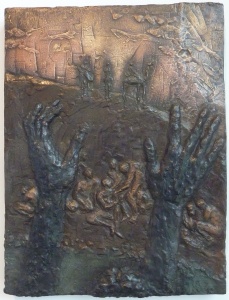
Jealousy and frustration likewise plays a central role in Joseph in the Pit. The innocent scene of the brothers sitting down to a mid-day meal is visually interrupted by the two desperate hands of Joseph reaching out of the foreground pit, futilely imploring Heaven for help against fraternal enmity. Tragically the only help at hand are the Midianite traders in the distance with their camels who will carry Joseph into Egyptian slavery.
The unfolding drama of the Exodus is re-conceptualized in The Pharaoh and his Army Follow the Children of Israel Across the Sea of Reeds. In the lower half we can make out a rough expressionist depiction of Pharaoh’s army seen from the back; just glimpsing a man standing in a chariot following masses of figures plunging into the narrow channel of the sea. Towering over the scene is a giant serpent swallowing two skinny snakes. In a brilliant and totally unique interpretation, Caspe has referenced Rabbeinu Bachya (Exodus 7:10) who comments that the miracle of Aaron’s staff swallowing the snakes of the Egyptian magicians foretold that the sea would frustrate Pharaoh’s plan and swallow his army. Startlingly, the primeval snake arises out of the Biblical narrative again to haunt mankind’s errant ways.
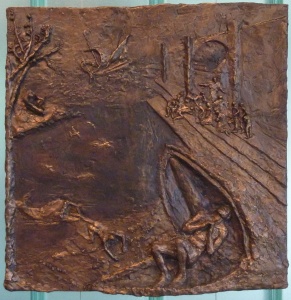
Indeed the forces of nature are cast as God’s agents to frustrate man in Jonah and the Whale. This is one of three reliefs that utilize the technique of continuous narrative (multiple scenes within a single frame) to flesh out the larger Biblical story. Jonah’s attempt to flee God’s command to prophesize to Nineveh is seen predominately within the framework of God-sent natural phenomena: the ship in the storm at sea; the giant fish capturing Jonah and then vomiting him out and finally Jonah confounded by the mysterious kikayon plant. Significantly, the panel creates a triad between Jonah in the mouth of the giant fish in the foreground, Jonah preaching to the Ninevehites in the upper right and finally Jonah under the kikayon in the upper left.It would seem that even though Jonah’s prayer for salvation from the fish is answered, he is nonetheless forced to preach to the idolatrous city and thereby implicitly embarrassing his Jewish brethren. Since this was exactly what he was trying to avoid, his despair under the kikayon plant fittingly concludes the narrative as it circles counter-clockwise reflecting the book’s puzzling conclusion.
Considering the fact that the Biblical narrative itself was entirely new for Caspe, the choice of the equally novel bronze reliefs as a medium is especially noteworthy. The “lost wax” method of bronze casting is complex and demanding. First a wax original must be sculpted; adding, subtracting and refining while heating and working the thermoplastic material. Then a mold is created from the original and a secondary wax ‘original’ is made which the artist must further refine. After this is cast by the foundry in molten bronze, the artist carefully works acid and chemicals into the surface to create the desired patina. Finally a clear wax is applied by the foundry workers to the 30 to 80 pound bronze sculptures. In these bronze works Caspe utilized both the bas-relief (low) and high relief techniques that have been used by artists for over 3000 years from ancient Egypt to contemporary times.
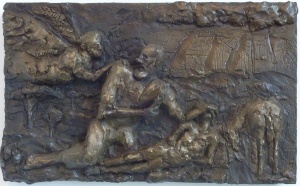
The Binding of Isaac is the first Biblical subject Caspe undertook and inaugurates the theme of frustration that runs through many of these works. Deceptively simple, the relief contains all the actors in the drama; angel, Abraham with the knife, Isaac bound and the donkey. Abraham is leaning towards his son ready to slay him as the angel just taps his shoulder. This gentle act causes Abraham to twist his head sharply to the right, heatedly glaring at the Divine messenger. All the commentaries agree that Abraham was totally committed to carry out God’s command to slay his son: but at this exact moment he is thwarted from doing God’s will. Caspe has captured our forefather’s piously shocking frustration.
Likewise her Jacob’s Ladder expresses a disquieting disjuncture. We see Jacob from above, his arms spread out in supplication, yearning for answers from the Divine vision that elude him as the angels flee up the ladder, just out of his grasp.
Lynda Caspe is a painter, sculptor, poet, teacher and curator who first explored Biblical subjects when she curated 11 artist’s works in Scenes from the Bible: Paintings and Relief Sculptures at the Synagogue for the Arts exhibition in October 2007 (Jewish Press: October 2, 2007). She has had numerous one-person shows, taught at Parsons School of Design, University of Alberta, University of Chicago and Manhattan Community College as well as helping establish the seminal artist’s cooperative, the Bowery Gallery, in 1969. While she has been drawn to the basic struggles of human nature that she finds played out in Biblical subjects, her view of the Divine role is dark and deeply modern, witnessed by the concluding verses of her poem: “God is the Ultimate Warrior”: “He makes a fortress out of darkness, Dark waters and thick clouds. He draws me out of the waters And delivers me to a wide space.”
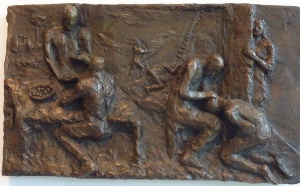
Caspe was initially drawn to narratives of fratricide and sibling rivalry that dominate Genesis: Cain and Abel; Jacob and Esau. The Birth of Jacob and Esau is a harrowing scene of two midwives assisting Rebecca in her travail. Each midwife is holding a newborn: the infant Jacob tenaciously grasps the heel of the first-born Esav, bringing the contentious relationship into the light of day. Only a woman could imagine this highly unusual image. Equally revealing is The Story of Jacob and Esau as the rivalry unfolds with the sale of the birthright depicted on the left and the stolen blessing on the right. Again utilizing a continuous narrative, Jacob is seen standing over the seated and ravenous Esau, compositionally balanced on the right with their father Isaac seated as Jacob kneels before him, impersonating his first-born brother. Significantly Rebecca stands over the duplicitous scene, clearly guiding the fraternal struggle to benefit her favored son. In some ways the manipulation of her husband Isaac and ostracism of her son Esau could not be crueler.
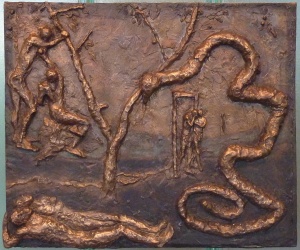
The Story of Adam and Eve, Caspe’s most recent bronze relief, attempts to uncover the “most basic struggle of our human nature, a struggle between good and evil…” As in many of these subjects she turned to Artscroll’s Stone Chumash (suggested by Rabbi Jonathan Glass of The Synagogue for the Arts) for inspiration and guidance from traditional commentaries. The Nefesh HaChaim (R. Chaim of Volozhin) explains that by eating from the Tree of Knowledge of Good and Evil, Adam and Eve “brought evil into themselves and made it part of their nature.”
Her image begins in the lower left with Adam and Eve depicted as not yet separated into two distinct beings. Then we see them next to the ill-fated tree, Eve handing Adam the fruit. Finally the parents of mankind exit the gates of the Garden ashamed and sorrowful. Dominating the entire scene is a giant deformed snake. As it arches up, its body twists at unnatural angles more broken than serpentine, clearly the dominant force in the unfolding story. Caspe’s artwork has shifted the narrative emphasis to the role of the Creator; revealing that our lifelong struggle with evil was engineered by the snake, a creature God placed in our perfect home. Our exile from the Garden seems inevitable; our struggle with evil pre-ordained. Caspe’s engagement with each one of these Torah narratives is unflinchingly critical and yields a unique interpretation, evidencing the rich complexity of the Biblical narrative and the sensitivity of her artistic vision.
Lynda Caspe: Biblical Reliefs and Cityscapes
The Derfner Judaica Museum
At The Hebrew Home for the Aged at Riverdale
5901 Palisade Avenue, Bronx, NY 10471-1205
(718) 581 1596 – http://hebrewhome.org/art.asp
Sunday-Thurs. 10:30-4:30pm; Free Admission
Until January 5, 2014